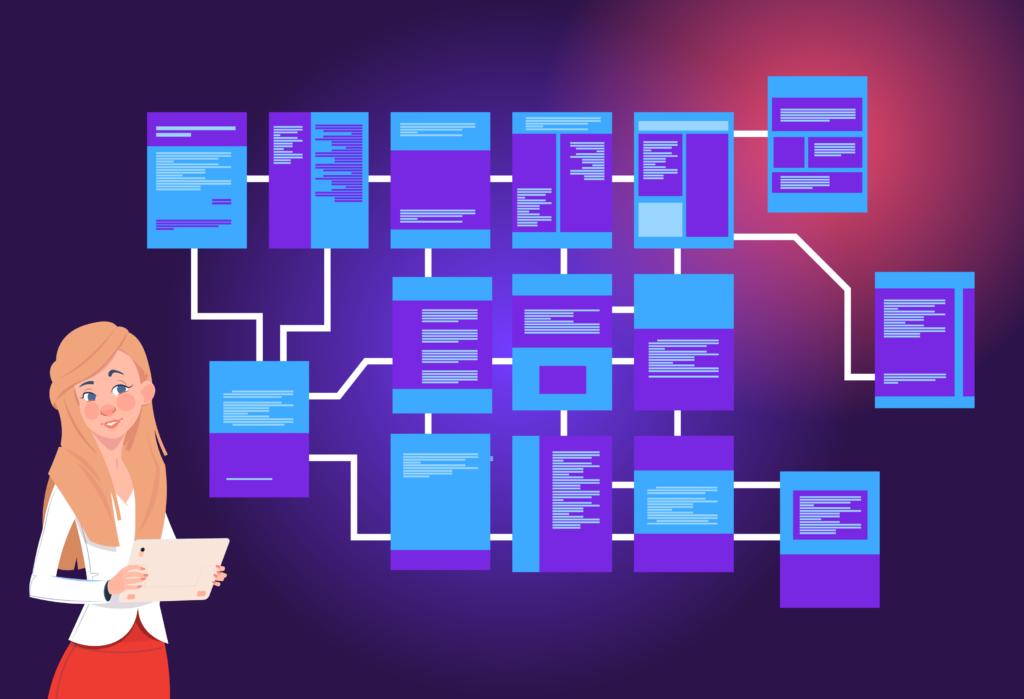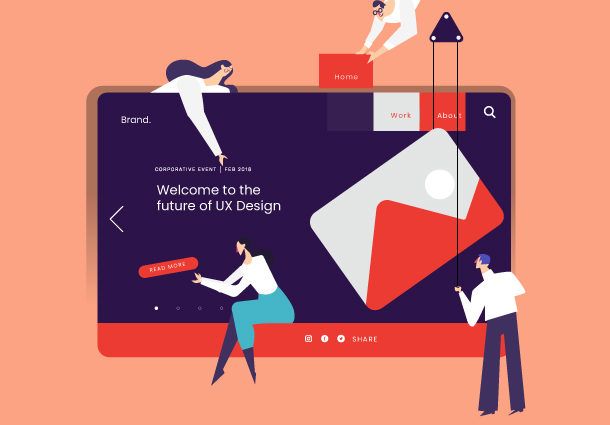Information Architecture- The lifeline of your website
What is Information Architecture? To answer this question, it is better to take a peek at the digital age. Information is the power bank of websites, and of course businesses. With information comes knowledge, which is mightier than any of the strongest words
in the world. With digitalization and the age of impatient new-gen skimming through your website, it is no longer sufficient to just have your content put forth on a website. You are supposed to organize the entire content. It should appear suave and elegant. by elegance, we don’t just mean the design and colors. It has got a lot to do with how you optimize your website content. The way you let your content appear has got a lot to do with sustaining your website users. Now let’s get deeper into Information Architecture. Wait, are you looking for the definition of Information Architecture? According to the Information Architecture Institute, Information architecture is the practice of deciding how to arrange the parts of something to be understandable.
Let’s explain this to you with a real-time example that we would have come across frequently. You and your team are all set to work on increasing the website traffic. It would not take place within a single day. It is going to take some time when you have just begun out. Tada! One fine day, you have a new website visitor. They have reached your landing page. Now all they did was to leave your page, increasing your bounce rate, which is going to appear like a Rube Goldberg machine. Reason? They were not able to find what they have been looking for. This is an extremely negative trait that you need to address immediately. When your website user is going to wonder what you are supposed to do next, you should understand that you are missing it out somewhere. They should never have any confusion regarding the website architecture. Never hesitate to make any changes when your website user is confused. It would all come up to you and impact on your bounce rate if you are not sorting it out fast.
Unleash the Potential of Information Architecture with Us
Creating a proper information architecture is as vital as your Google map when you are All set to voyage at an unknown island. Wouldn’t it be nice when you know where the restaurant is, which shop  you need to head to when you need to buy your sanitary Items? Wouldn’t you need all the information from your Google map? Similarly, your Information Architecture is going to provide directions for your website visitors on where they need to sprint when they need something specific. In this age of information and data, the term information architecture is nothing new. You can find it almost anywhere including your website, mobile apps and much more. Not just in your online virtual world, you get to see it elsewhere in your offline world in the form of e-brochures and catalogs. You can find Information architecture everywhere! The purpose of a great Information Architecture guide is to let people understand more about the website they visit and what they have been looking for. When you are all set to practice information architecture and start facilitating your organizations and people to work together, it is time for you to consider your structures as well as the language without fail. In a nutshell, when you are into making things meant for other people, you are actually practicing information architecture.
you need to head to when you need to buy your sanitary Items? Wouldn’t you need all the information from your Google map? Similarly, your Information Architecture is going to provide directions for your website visitors on where they need to sprint when they need something specific. In this age of information and data, the term information architecture is nothing new. You can find it almost anywhere including your website, mobile apps and much more. Not just in your online virtual world, you get to see it elsewhere in your offline world in the form of e-brochures and catalogs. You can find Information architecture everywhere! The purpose of a great Information Architecture guide is to let people understand more about the website they visit and what they have been looking for. When you are all set to practice information architecture and start facilitating your organizations and people to work together, it is time for you to consider your structures as well as the language without fail. In a nutshell, when you are into making things meant for other people, you are actually practicing information architecture.
Information Architecture acts as a strong base for your UX Design. Everybody is going to be curious about Your website. They would love to know how your user experience (UX) is all set to be. Not just in UX, you need to master this skill set when you are working on your content strategy, library science, technical writing along with interaction design. Even if you are all set to create a PowerPoint presentation, you would need to hone up your information architecture. You don’t want to end up with a boring presentation session, do you?
Every company has to focus on organizing their information according to the whimsical of the website. They should have a proper strategy to organize the content in place before they move on to the website publication. Your Information Architecture has to support your audience in their pursuit of looking for the right information. You need to know how to put up your information in front of your users. To ensure that all this happens, it is necessary to come up with your own information architecture. When you are into creating your own information architecture, there are numerous factors that you need to look upon with regards to this aspect
Dan Brown’s Information Architecture principles for designers
Everybody would not be familiar with the core principles of IA put forth by Dan Brown, the famous UX Designer, and Information Architect, that they need to ponder over. Without any plan or basic knowledge about the Information architecture principles for designers would turn fatal for the design processes. That would add more chaos and apocalypse among the designers. These are the Information Architecture principles that we need to look into:
Object Principle
The best UX UI design company for Information Architecture would not allow you to see the website content as robotic stuff. We should perceive it as an object that is very much alive. Every object consists of behaviors, lifecycle, and attributes. We create objects on the basis of a template that is already existent, which is also known as Class in programming. Our core job as a designer would be to create a template as per the object.
Disclosure Principle
Humans would only be able to process to an extent. We would be capable of using what we know when we want to predict what is coming up next. The main purpose of the disclosure principle is to let people understand that there is only sufficient information meant for people to understand. Once this is done, they are all set to decide how they can get inside this deeply.
Choice Principle
When there are more choices or information overload, people are going to find it hard to make a proper decision. Hence we would require a set of focused and more meaningful choices.
Exemplar Principle
Many cognitive scientists have understood that our brains are capable of representing different categories as networks meant for better examples. Elaborate descriptions are not going to work out really well. If we can come up with proper examples, we can do the explaining in a far better manner.
Front Door Principle
It is not that every website user is going to visit your website through your home page. Some might visit your service page directly. Not just that, nearly half of your website users are going to visit your website through other pages. Even though people can enter your website indirectly, your website should give proper information on what information it holds.
Multiple Classification Principle
People use various ways to look at the information they need. Our design should support people with this endeavor. We should make sure that we offer various classification systems to let people locate the content. This is not something you need to overdo. People could also find too much information to be irritating and annoying.
Focused Navigation Principle
Focus on your navigation schemes. It should not hold any contagious links. This is going to offer every menu with a purpose to refer to. When you have a picture-perfect menu, it is going to allow you to focus on helping your design team communicate more about the navigation menu. Timely navigation happens only when you have proper links present in the subtopics. The name should give an idea on the purpose, not just other details like location and name of the admin.
Growth Principle
Today’s content is going to hold a fraction of your tomorrow’s content. The goal of the designer should be to create a page with anticipation in the form of content, presentations, videos, galleries, blogs and much more. We should also focus on future-proofing our menu, just like how we did it in navigation. If you are feeling that your design would require more navigation schemes, then you are not going to get a glimpse of growth possibility. In short, menus are meant to anticipate what new topics we can need. Your page should focus on the style of content you can make use of.
Importance of IA
It is through IA that you get to organize your website and put it on display. With that, you would be able to navigate it and carry out different functions. This is going to include everything right from the site language, menu, page organization and see how you are going to set up the page for yourself. This is going to ensure easier navigation. Your website architecture should provide proper navigation options to your user. It should include less effort from your side. You should present your content in a more logical manner. When you want to create a proper IA, you might require to carry out a few research to get into the brains of your users.Many activities such as card sorting would be able to decorate the participant group with the right info as well as letting you rediscover any sort of insights and information on your website. The best way to do user testing using prototypes of any product is to understand the user flow along with identifying the website parts that would require more efforts to work on. With a proper IA, you are going to get a competitive edge. Any user would wish to perform the tasks using minimal effort. They would choose which product they are going to use while they are into creating the most appealing experience for their user. If you need good experience, the beginning point would be to produce a great design. Your user should feel it quite natural and not thrown away.
the site language, menu, page organization and see how you are going to set up the page for yourself. This is going to ensure easier navigation. Your website architecture should provide proper navigation options to your user. It should include less effort from your side. You should present your content in a more logical manner. When you want to create a proper IA, you might require to carry out a few research to get into the brains of your users.Many activities such as card sorting would be able to decorate the participant group with the right info as well as letting you rediscover any sort of insights and information on your website. The best way to do user testing using prototypes of any product is to understand the user flow along with identifying the website parts that would require more efforts to work on. With a proper IA, you are going to get a competitive edge. Any user would wish to perform the tasks using minimal effort. They would choose which product they are going to use while they are into creating the most appealing experience for their user. If you need good experience, the beginning point would be to produce a great design. Your user should feel it quite natural and not thrown away.
Don’ts of Information Architecture:
Creating your own information architecture is going to be a lifelong journey for your website. Your Information Architecture should have a proper structure. Just like any building, it has to hold a strong basic foundation. You need to consider a number of factors that you should not do. These are a few of them:
Don’t forget the website loop
The designers forget that their website has many sub-pages within itself. As time goes on, they start treating it as if it is a one-stop webpage where you can dump all the data. Without any basic organizing principle, it is hard for any individual designer to organize the entire content, especially when the sector is e-commerce. They do not follow any organizing principle that they need to remember always. Treating your website as a standalone product is going to make it extremely harder. Hence you should refrain from doing that. This is going to make your users leave your website soon, paving way for more bounce rate. You are not going to integrate your structure and search.
Users demand more search-dominant behavior
You should not forget that users would always exhibit more search-dominant behaviours. It is unusual that your user would exactly reach where they were destined and hoped to. It is your duty to navigate them to the website. SERP (Search Engine Results Page) usability is going to increase when every search hit is going to expose the location within its site structure. Not every external search engine would be aware of this since they are not going to give the relevant information. Hence navigation designs that would not sync up with the interest of the user are of no use. The best Information architecture principles would involve carrying out search-dominant behaviour. It is going to make the best out of the SEO, user-demands and many other factors. Statistics state that 75% of the people are not going past the first page on the search engine. You have to keep in mind all these factors while creating content for your user. At the end of the day, it is your customers who are going to consume the content or information you have put across on the website. Hence you need to be conscious of their search preference.
to navigate them to the website. SERP (Search Engine Results Page) usability is going to increase when every search hit is going to expose the location within its site structure. Not every external search engine would be aware of this since they are not going to give the relevant information. Hence navigation designs that would not sync up with the interest of the user are of no use. The best Information architecture principles would involve carrying out search-dominant behaviour. It is going to make the best out of the SEO, user-demands and many other factors. Statistics state that 75% of the people are not going past the first page on the search engine. You have to keep in mind all these factors while creating content for your user. At the end of the day, it is your customers who are going to consume the content or information you have put across on the website. Hence you need to be conscious of their search preference.
Don’t hold up more than one category
It is always recommended for any website to hold a number of categories. It should be linking up to the landing page giving every user an overview of the section. At times, your website is going to go through a few changes in the page overview. It could also link up to other single pages within the section. It is always good to have category pages since they would help the SEO. But as they say, too much of anything is good for anything. Having too many sub-sections is going to impact heavily on your SEO. It is not suggested to create multiple categories and keep listing everything within them. It is going to look extremely clumsy. If there are many breadcrumbs, it is going to impact your users heavily.
Integrate your subsites and microsites
Without integrating your microsites and subsites properly to the main site, it would be extremely hard for your users to understand where your website is. Website design is how you design for the present age. You need to integrate your website to match with the overall structure of your website. When we are sharing the content, we see that the information appearing on pages with poorly maintained subpages would not get ranked in a better manner.
How to design information architecture
Designing your information architecture is not going to demand more of your struggle if you have the right team to support you. All you need to do is to follow these five steps to create that snacky information architecture:
It’s time for you to conduct proper customer research
To create an effective website, you need to start with your customers. Your website should be made for your customer, of your customer and by your customer. They should be the driving force behind your website.
Don’t forget to keep updating your content:
Your content should appear as per the current trend. The information you have put up in 2005 on your website is not going to match up now. With new content, not only your website visitors would know that your business is up and running. They would start giving that extra attention we always crave for our brand.
Review your content:
Reviewing your content and design as frequently as possible is very much important if you want to get rid of broken links and navigation issues. You need to check if there are any mistakes in the content.  Your content should be clear, concise and precise. If you have any unclear or fluffy content on your page, it is always suggested by the experts to remove it. The power of simplicity is more, while we talk in terms of content! It is always advisable to see that your navigation options are not invisible, confusing and inconsistent. It should have a proper setup. You should always avoid any made-up options in the menu. Your user should have a clear picture of how your website appears and how to move on to the next pages. They should not get interrupted or feel confused in between. Once you finish writing your content, make sure that all these factors are covered. These are going to give you an add-on advantage on various business processes that are in practice, thus sustaining to your audience’s expectations on the content. Ensure that you have covered everything from grammar check to navigation before you hit the publish button.
Your content should be clear, concise and precise. If you have any unclear or fluffy content on your page, it is always suggested by the experts to remove it. The power of simplicity is more, while we talk in terms of content! It is always advisable to see that your navigation options are not invisible, confusing and inconsistent. It should have a proper setup. You should always avoid any made-up options in the menu. Your user should have a clear picture of how your website appears and how to move on to the next pages. They should not get interrupted or feel confused in between. Once you finish writing your content, make sure that all these factors are covered. These are going to give you an add-on advantage on various business processes that are in practice, thus sustaining to your audience’s expectations on the content. Ensure that you have covered everything from grammar check to navigation before you hit the publish button.
Classify content using card sorting:
In the information architecture process, card sorting is one of the ways when you let your audience decide what they want to see and what they don’t. Card sorting comes under three main categories. It can be open, hybrid and closed. The open card sorting comes under free labeling. The participants are all set to choose and categorize the topics as per their requirements. You get to understand what your user’s ideology is when you are classifying the content. With the closed card category, you have more predefined categories. We use closed methods in redesigning the product whereas open methods come under creating a new product. You can make use of a content inventory list for card sorting. The hybrid category is used to unite different elements belonging to both the types of open and closed cards. Or else, it can start on with open type and slowly move on to closed type as per your user’s logic.
Build a proper website hierarchy:
Your website should hold a proper hierarchy. It should be well-defined and properly planned. Start building your website hierarchy with the help of your designers, much earlier before you start on with your website content creation. Your visual hierarchy also matters the most in your Information Architecture process.
Take care of the website navigation:
You don’t want to let your website navigation ruin your traffic day! Ensure that the website links work properly. In the information architecture process, your website navigation is also going to consume a primary space since it is how your users switch over from one place to the other.
Leverage your UI/UX prototype for an excellent depiction:
The next step after you define your information architecture is to create a UI/UX prototype defining the content and design of your website. It should be condensed with industry standards.  Nobody believes in textual content anymore. People believe in seeing what they are going to believe. Hence it would be wise of you to offer a proper UI/UX prototype to your user. Building the best UI/UX prototype is going to amount to the credibility of your website. You need to be a pro in designing your prototype. Ensure that you leverage the best prototyping tools like Indesign and Sketch when you want to build the best UX prototype. Being a designer is not just about creating a prototype. It is also about understanding the mindset of your user and concluding their expectations in the right manner. If you can create the best prototype, it is going to help you out in getting to know the perspective of your users. You are going to become unstoppable when you can create the best ever UI/UX prototype. This is also going to help your Information Architecture process. Ensure that you also follow the Information Architecture principles.
Nobody believes in textual content anymore. People believe in seeing what they are going to believe. Hence it would be wise of you to offer a proper UI/UX prototype to your user. Building the best UI/UX prototype is going to amount to the credibility of your website. You need to be a pro in designing your prototype. Ensure that you leverage the best prototyping tools like Indesign and Sketch when you want to build the best UX prototype. Being a designer is not just about creating a prototype. It is also about understanding the mindset of your user and concluding their expectations in the right manner. If you can create the best prototype, it is going to help you out in getting to know the perspective of your users. You are going to become unstoppable when you can create the best ever UI/UX prototype. This is also going to help your Information Architecture process. Ensure that you also follow the Information Architecture principles.
Do you have the right information architecture in place?
Creating your very own information architecture needs proper navigation and visual prototype. The primary objective behind creating an information architecture is to let your user feel at ease when they arrive at your website. By following the Information architecture principles and religiously taking notes of the Information architecture process, you are all set to go for good! If you need additional support, it is always good to have a talk with the mentor!
How can Pattem Digital help you with your Information architecture?
When you are planning to create your own information architecture, you need to choose the best UX Design company. They should have knowledge about the top industry processes.
Creating your own Information Architecture is a time-consuming process. It gets complex when you do not have the right team support. To get rid of all those adversities, it’s time for you to hire Pattem Digital.
Unlock fulfilling websites experience with Pattem Digital
We at Pattem Digital can confidently support our assertions and demonstrate our proficiency in information architecture services. Our strategy is based on transparency and the strength of numbers. We are committed to giving your users outstanding online experiences as one of the top UX/UI design firms with a focus on information architecture. As a result of our successful partnerships with leading companies all around the world, our track record speaks for itself. Our team is dedicated to assisting you at every stage, from thorough documentation to trustworthy maintenance.


